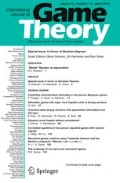Abstract.
A major issue within the realm of Antitrust policy is the regulation of existing monopolies. We describe a new potential indirect scheme for regulating a natural monopoly that arises from high entry cost. The approach involves minimal government intervention, and it is based on encouraging entry by offering to subsidize entry cost for potential competitors. We pose this issue as a four-stage non-cooperative game. Analysis of sub-game perfect Nash equilibria of the game reveals that the first best outcome is achieved as the unique equilibrium in which the monopolist prices at marginal cost and there is no entry. The regulation is “costless,” since no entry will occur and hence no subsidy will be paid.
Similar content being viewed by others
Author information
Authors and Affiliations
Additional information
Received June 1995
Rights and permissions
About this article
Cite this article
(Burnovski), M., Zang, I. “Costless” regulation of monopolies with large entry cost: A game theoretic approach. Game Theory 28, 35–52 (1999). https://doi.org/10.1007/s001820050097
Issue Date:
DOI: https://doi.org/10.1007/s001820050097




